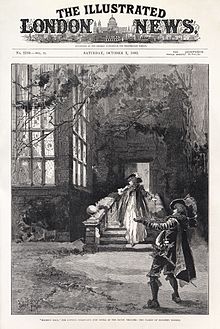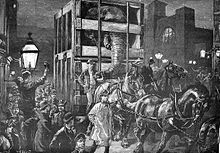The Illustrated London News
 Front-page of the magazine's first issue (May 14, 1842) | |
| Type | Weekly (1842–1971) Monthly (1971–1989) Quarterly (1989–1994) Twice-yearly (1994–2003) |
|---|---|
| Format | Broadsheet newsmagazine |
| Owner(s) | Illustrated London News Group |
| Founded | 1842 |
| Political alignment | Conservative |
| Ceased publication | 2003 |
| Headquarters | London, England |
| Website | www |
The Illustrated London News, founded by Herbert Ingram and first published on Saturday 14 May 1842, was the world's first illustrated weekly news magazine.[1] The magazine was published weekly for most of its existence, switched to a less frequent publication schedule in 1971, and eventually ceased publication in 2003. The company continues today as Illustrated London News Ltd, a publishing, content, and digital agency in London, which holds the publication and business archives of the magazine.
History
1842–1860: Herbert Ingram

The Illustrated London News founder Herbert Ingram was born in Boston, Lincolnshire, in 1811, and opened a printing, newsagent, and bookselling business in Nottingham around 1834 in partnership with his brother-in-law, Nathaniel Cooke.[2] As a newsagent, Ingram was struck by the reliable increase in newspaper sales when they featured pictures and shocking stories. Ingram began to plan a weekly newspaper that would contain pictures in every edition.[3]
Ingram rented an office, recruited artists and reporters, and employed as his editor Frederick William Naylor Bayley (1808–1853), formerly editor of the National Omnibus. The first issue of The Illustrated London News appeared on Saturday, 14 May 1842, timed to report on the young Queen Victoria's first masquerade ball.[4] Its 16 pages and 32 wood engravings covered topics such as the war in Afghanistan, the Versailles rail accident, a survey of the candidates for the US presidential election, extensive crime reports, theatre and book reviews, and a list of births, marriages, and deaths. Ingram hired 200 men to carry placards through the streets of London promoting the first edition of his new newspaper.[5]

Costing sixpence, the first issue sold 26,000 copies. Despite this initial success, sales of the second and subsequent editions were disappointing. However, Ingram was determined to make his newspaper a success, and sent every clergyman in the country a copy of the edition that contained illustrations of the installation of the Archbishop of Canterbury, and by this means secured a great many new subscribers.
Its circulation soon increased to 40,000, and by the end of its first year was 60,000. In 1851, after the newspaper published Joseph Paxton's designs for the Crystal Palace before even Prince Albert had seen them, the circulation rose to 130,000. In 1852, when it produced a special edition covering the funeral of the Duke of Wellington, sales increased to 150,000; and in 1855, mainly due to the newspaper reproducing some of Roger Fenton's pioneering photographs of the Crimean War (and also due to the abolition of the Stamp Act that taxed newspapers), it sold 200,000 copies per week.[5]
Competitors soon began to appear; Lloyd's Illustrated Paper was founded later that year, while Reynold's Newspaper opened in 1850; both were successful Victorian publications, albeit less successful than The Illustrated London News.[6] Andrew Spottiswoode's Pictorial Times lost £20,000 before it was sold to Ingram by Henry Vizetelly, who had left the ILN to found it.[7] Ingram folded it into another purchase, The Lady's Newspaper, which became The Lady's Newspaper and Pictorial Times. Vizetelly was also behind a later competitor, Illustrated Times in 1855, which was similarly bought out by Ingram in 1859.[citation needed]
Ingram's other early collaborators left the business in the 1850s. Nathanial Cooke, his business partner and brother-in-law, found himself in a subordinate role in the business and parted on bad terms around 1854. The departure of William Little was in 1858; in addition to providing a loan of £10,000, he was the printer and publisher of the paper for 15 years. Little's relationship with Ingram deteriorated over Ingram's harassment of their mutual sister-in-law.[2]
Herbert Ingram died on 8 September 1860 in a paddle-steamer accident on Lake Michigan, and he was succeeded as proprietor by his youngest son, William Ingram, who in turn was succeeded by his son, Sir Bruce Ingram (1877–1963) in 1900, who remained as editor until his death.